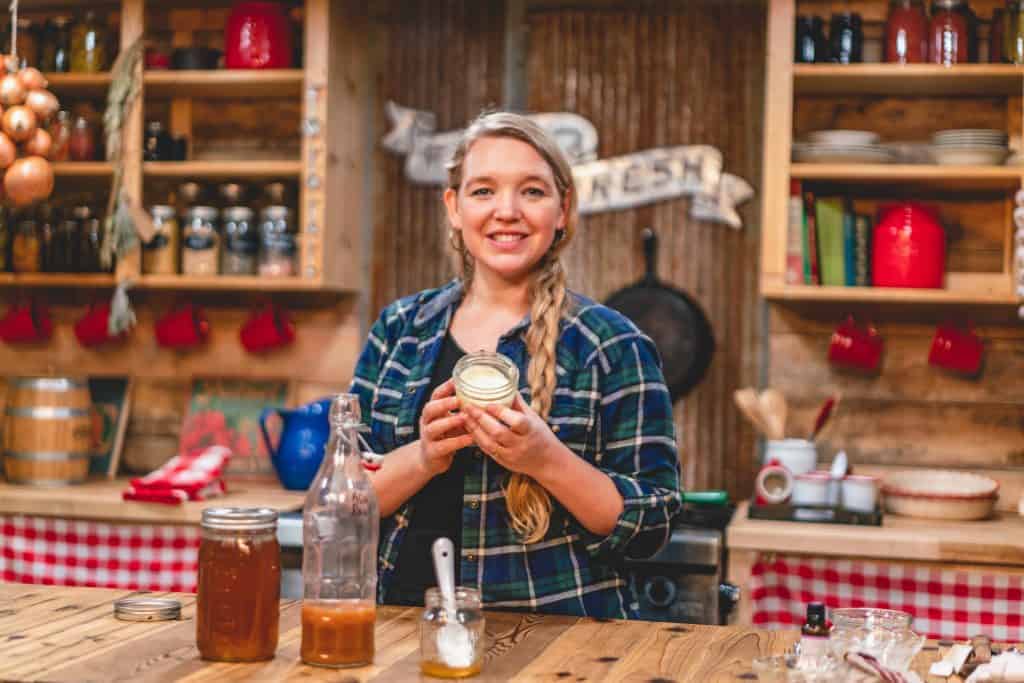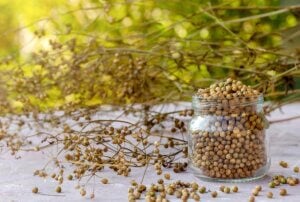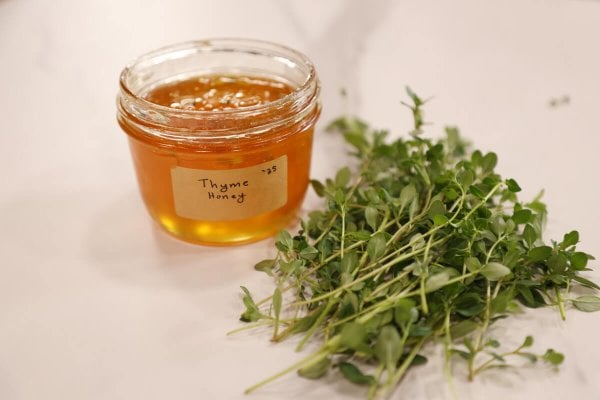Vinegar is a versatile homesteading staple, and when you grow your own apples, you’ll want to use every part of the harvest that you can. Learn how to make apple scrap vinegar, and you will use it in everything from your favorite food and drink recipes to cleaning your windows and coffee pot.

Why I Love Apple Scrap Vinegar
Fall is my favorite time of year. The sun is still warm, but the crisp breeze signals it’s time to pull out the cozy sweaters and fire up the wood cookstove. There, you will find all sorts of goodies simmering and bubbling all day.
From hearty beef stew or white bean chicken chili, nothing compares to wood-cooked foods’ taste.
And then there are the apples. We enjoy a bountiful harvest when we tend to our orchards and correctly prune our apple trees. We store big bins of apples in our unheated, uninsulated garage, carefully blanketing them if frigid weather sets in.
It’s possible to enjoy fresh apples until February with this method. Still, we also preserve our apples using fermentation, such as in this homemade fermented cranberry sauce, apple jalapeño sauerkraut recipe, or sparkling apple cider recipe.
Making caramel apples, Apple Brown Betty, or fresh pressed apple cider is always a hit with the kids, and I use the cider to sweeten my home-canned cherries naturally.
Apple sauce, apple butter, and dehydrated apple rings or freeze-dried apples for snacks are all found in the recesses of my well-stocked pantry, leaving an excess of apple scraps to use up.
While I can toss these scraps to our backyard chickens or put them in our compost pile, there is yet another pantry staple I can make promoting a zero-waste home. Enter apple scrap vinegar. It is a wonderful way to use up the skins and cores of your apples to make something incredibly valuable in the kitchen.

What Is Apple Scrap Vinegar
It’s important to note that there is a difference between homemade apple scrap vinegar and real apple cider vinegar. While apple scrap vinegar is made from apple peelings and cores, homemade apple cider vinegar is made from the juice of the whole apple.
Apple scrap vinegar tends to have a milder and less acidic taste, which many find more appealing when used in recipes. However, due to its lower acid level, apple scrap vinegar is not suitable for canning recipes such as these homemade pickles. Homesteading Hack: I don’t recommend using any homemade vinegars for canning as you can’t properly test the acidity level.

The Secret to Apple Scrap Vinegar
I preserved anything I could find at the beginning of our homesteading journey. It’s no wonder I was intrigued when reading Farmer Boy to our children and came across a line about apple-core vinegar.
Armed with my favorite homesteading books, I had a basic foundational understanding of how it works. The first time I made fruit scrap vinegar, it was okay but not great.
It wasn’t until we learned how to make hard cider that I realized the trick to good vinegar is a sugar of some kind because the simple truth is that one needs alcohol for good vinegar.
As for the sugar, it is yeast food, so it doesn’t matter what you use (white or brown sugar, molasses or honey); the yeasts don’t care. However, it does need to be natural sugar (not sugar alcohols), and molasses and honey will impart different flavors in your final vinegar.

Health Benefits of Apple Scrap Vinegar
There is information floating around on the internet that raw apple cider vinegar may help lower blood sugars to control diabetes, could help with weight loss, and may improve heart health. (Source)
We need more studies to substantiate this, but we know that apple scrap vinegar is a fermented food full of beneficial enzymes and bacteria that support gut health. (Source)
Since the vast majority of our immune system is in our gut, it’s really important to make sure your digestion is working well. Apple scrap vinegar is an easy way to incorporate fermented foods into your diet to boost your immune system naturally. (Source)
It’s important to note that I am not a certified medical practitioner. This post is not intended to diagnose or treat but is for informational purposes only. Please contact your healthcare professional before introducing new herbal and natural remedies into your wellness routine.

Ways to Use Apple Scrap Vinegar
As mentioned before, apple scrap vinegar is unsuitable for canning, but numerous ways exist to put this pantry staple to work:
- Home Remedies – Apple scrap vinegar is a star ingredient in this Immune Boosting Tea and Home Remedies for a Cough.
- Bone Broth – Using vinegar when making bone broth can help pull out the nutritious minerals and gelatin from the bones. Add it to the pot of water and let it sit for 20-60 minutes prior to making broth.
- DIY Energy Drink – Use apple scrap vinegar in this Switchel Recipe as a natural hydrating sports drink on a hot summer day.
- Condiments – Fermented Ketchup, Homemade Mustard, and Homemade Vinaigrette Dressing are all delicious made with apple scrap vinegar.
- Snacks – The Best Pickled Eggs and Easy Refrigerator Pickles rely on good quality vinegar to bring out their best flavors.
- Household Cleaners – Vinegar makes an effective cleaning product. Try this Homemade Glass Cleaner for an easy nontoxic recipe. Homesteading Hack: Strain the vinegar prior to making the glass cleaner, as the Mother can tend to leave streaks.

Supplies Needed
- Glass Jar – ½ gallon or 2 quart Mason jars work well for this recipe.
- Measuring Cup – You can use a quart Mason jar to measure instead of using a measuring cup to add one cup of water at a time.
- Wooden Spoon – A metal spoon can react with the acetic acid of your ferments, creating a metallic taste. Using wooden or silicone utensils works best.
- Unbleached Cotton – You do not need a fermenting weight to make apple scrap vinegar. Simply use unbleached cotton, butter muslin, a clean tea towel, or tight weave cheesecloth to cover the top of the jar.
- String – You can use string (or a rubber band) to secure the cover over your jar.
- Sterilized Bottle – This apple scrap vinegar can last indefinitely when stored in a sterilized container.

Ingredients Needed
- 1 Pound (.5 kg) Apple Scraps, Cores and Peels – You can use any variety of apples for this recipe, but organic apples are best.
- 1 Cup (208 g) Sugar – While any kind of real sugar may be used (white sugar, brown sugar, molasses, honey, etc.), you CANNOT use alternative sweeteners such as stevia, erythritol, xylitol, monk fruit, etc.
- ½ Cup (120 ml) Raw Unfiltered Cider Vinegar – Make sure your ACV is unpasteurized or has a vinegar mother. This acts as the “starter liquid” to inoculate your apple scrap vinegar.
- 2 Quarts (2 liters) Filtered Tap Water – For best results, do not use chlorinated water.

How to Make Apple Scrap Vinegar
- Put the fruit and sugar into a 1⁄2 gallon (2 liter) jar. Add 1 quart (1 liter) of the water and the raw vinegar. Use the rest of the water to cover the apples up to the neck of the jar.
- Stir the sugar, water, and fruit scraps with a wooden spoon, and you will stir again once a day for the first 5 or 6 days. (Unlike most ferments, you want some oxygen in the mix.)
- Cover the jar with unbleached cotton and secure it with a rubber band or string.
- Place on the counter or another spot around 70°F to 80°F (21-26°C), above the refrigerator works well. You may see bubbles, which is good. The ferment will begin to slow down in about two weeks.
- After the fermenting bubbles slow down, it is time to remove the scraps. You may see a film developing on top when you remove the cover. If so, work carefully to keep it because this film is the beginning of the vinegar mother. Homesteading Hack: You can set the film aside while straining out the fruit solids, then add it back into the vinegar.
- Cover it again and let it continue to sit on the shelf.
- Check the vinegar in another month, and you should have nice acidity; however, it may take another month or two to develop fully.
- Bottle the vinegar, save the mother for another batch or share with a friend.
- You can use the vinegar immediately, or you can age the vinegar to mellow the flavor.
- Apple scrap vinegar will last indefinitely at room temperature.
Did you make this recipe? If so, please leave a star rating in the recipe card below. Then snap a photo and tag us on social media @homesteadingfamily so we can see!

The Homestead Kitchen
This recipe for apple scrap vinegar was featured in issue No.2 of the Homestead Kitchen magazine. If you are ready to master your homestead kitchen, this affordable magazine was curated with you in mind.
It’s packed full of cream-of-the-crop homesteading information, including recipes, DIY instructions, inspirational stories, homesteading hacks, book reviews, gardening tips, kids’ projects and more. We can’t wait to share it with you!
If you’re ready to spend less time striving in the kitchen and more time enjoying it then subscribe today to have your monthly copy delivered right to your mailbox.

Other Articles You May Enjoy
- The Importance of Traditional Whole Foods
- Switchel Recipe (Apple Cider Vinegar Drink or Haymaker’s Punch)
- The Best Pickled Eggs Recipe – Easy Egg Preservation Method
- Easy Healthy Broccoli Salad Recipe
- Ginger Bug: Make Your Own Probiotic Fizzy Drinks
- Quick & Easy Refrigerator Pickles (Garlic Dill Pickles)
- Fermented Ketchup (Easy, Homemade, Probiotic & Kids Love It)

Apple Scrap Vinegar
Ingredients
- 1 pound apple scraps cores, peels, etc.
- 1 cup sugar
- ½ cup apple cider vinegar raw and unfiltered
- 2 quarts filtered water
Instructions
- Put the fruit and sugar into a 1⁄2 gallon (2 liter) jar. Add 1 quart (1 liter) of the water and the raw vinegar. Use the rest of the water to cover the apples up to the neck of the jar.
- Stir the sugar, water, and fruit scraps with a wooden spoon, and you will stir again once a day for the first 5 or 6 days. (Unlike most ferments, you want some oxygen in the mix.)
- Cover the jar with unbleached cotton and secure it with a rubber band or string.
- Place on the counter or another spot around 70°F to 80°F (21-26°C), above the refrigerator works well. You may see bubbles, which is good. The ferment will begin to slow down in about two weeks.
- After the fermenting bubbles slow down, it is time to remove the scraps. You may see a film developing on top when you remove the cover. If so, work carefully to keep it because this film is the beginning of the vinegar mother. Homesteading Hack: You can set the film aside while straining out the fruit solids, then add it back into the vinegar.
- Cover it again and let it continue to sit on the shelf.
- Check the vinegar in another month, and you should have nice acidity; however, it may take another month or two to develop fully.
- Bottle the vinegar, save the mother for another batch or share with a friend.
- You can use the vinegar immediately, or you can age the vinegar to mellow the flavor.
- Apple scrap vinegar will last indefinitely at room temperature.
Notes
- Bottle the vinegar, save the mother for another batch or share with a friend.
- You can use the vinegar immediately, or you can age the vinegar to mellow the flavor.
- Apple scrap vinegar will last indefinitely at room temperature.


















